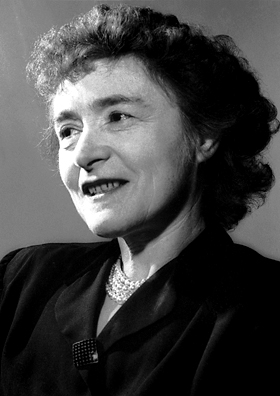Gerty Cori facts for kids
Quick facts for kids
Gerty Cori
|
|
|---|---|

Cori in 1947
|
|
| Born |
Gerty Theresa Radnitz
August 15, 1896 |
| Died | October 26, 1957 (aged 61) Glendale, Missouri, U.S.
|
| Nationality |
|
| Alma mater | Karl-Ferdinands-Universität in Prague |
| Known for |
|
| Spouse(s) | |
| Children | 1 |
| Awards |
|
| Scientific career | |
| Fields | Biochemistry |
| Institutions | Washington University Medical School |

Gerty Theresa Cori (born Radnitz; August 15, 1896 – October 26, 1957) was a brilliant scientist from what is now the Czech Republic. She became an American citizen later in her life. In 1947, she made history as the third woman to win a Nobel Prize in science. She was also the very first woman to receive the Nobel Prize in Physiology or Medicine. She earned this amazing award for her important discovery about how the body uses glycogen for energy.
Gerty was born in Prague, which was then part of the Austro-Hungarian Empire. She was named Gerty, not as a nickname, but after an Austrian warship! When she was growing up, it was very hard for women to get an education in science. But Gerty was determined. She got into medical school, where she met her future husband, Carl Ferdinand Cori. They married in 1920 after they both graduated. Because life was difficult in Europe after World War I, they moved to the United States in 1922.
Gerty loved medical research and worked closely with Carl in the lab. She published many research papers, some with her husband and some by herself. Even though she was a talented scientist, it was often hard for her to find good research jobs. The jobs she did get paid very little compared to what men earned. Her husband, Carl, always wanted to work with her, even when his employers tried to stop them.
In 1947, Gerty Cori, her husband Carl, and another scientist named Bernardo Houssay won the Nobel Prize. They discovered how glycogen (a type of sugar stored in the body) breaks down in muscles to create lactic acid. They also found out how the body then turns this lactic acid back into glycogen to store energy. This process is now called the Cori cycle. They also found an important chemical compound called the Cori ester. Gerty and Carl were only the third married couple ever to win a Nobel Prize! In 2004, their work on how the body uses sugars was recognized as a National Historic Chemical Landmark.
Gerty Cori continued her research until she passed away in 1957. She had been battling a serious illness for ten years. She received many awards and honors for her amazing work.
Contents
Early Life and Education
Gerty Theresa Radnitz was born in Prague in 1896. Her father, Otto Radnitz, was a chemist who became a manager of sugar factories. He invented a successful way to refine sugar. Her mother, Martha, was a cultured woman who was friends with the famous writer Franz Kafka.
Gerty was taught at home before going to a girls' school. When she was 16, she decided she wanted to become a medical doctor. To study science, she realized she needed to catch up on subjects like Latin, physics, chemistry, and math. In just one year, she studied as much as most students learn in many years!
Her uncle, who was a professor of pediatrics (children's medicine), encouraged her to go to medical school. She studied hard and passed the university entrance exam. In 1914, she was accepted into the medical school at Charles University in Prague. This was a very rare achievement for women at that time.
Marriage and Early Career
While studying, Gerty met Carl Ferdinand Cori. Carl was immediately impressed by her charm, energy, sense of humor, and her love for the outdoors and mountain climbing. Both Gerty and Carl started medical school at 18 and graduated in 1920. They got married that same year. They moved to Vienna, the capital of Austria. Gerty worked at the Carolinen Children's Hospital for two years, and Carl worked in a laboratory. At the hospital, Gerty studied children's health and did experiments on body temperature. She also published papers about blood problems.
Carl had to serve in the Austrian army during World War I. Life was very hard after the war. Gerty even suffered from eye problems because there wasn't enough food. These difficulties, along with growing prejudice against certain groups, led the Coris to decide to leave Europe.
Working in the United States
In 1922, Gerty and Carl both moved to the United States. Gerty arrived six months after Carl because it was hard for her to get a job offer. They wanted to continue their medical research at what is now the Roswell Park Cancer Institute in Buffalo, New York. In 1928, they became American citizens.
The director of the Institute actually threatened to fire Gerty if she kept working with her husband. But she continued to collaborate with Carl, and luckily, she was allowed to stay at the Institute.
Even though they were discouraged from working together, the Coris continued their research. They focused on how the body uses carbohydrates (sugars and starches). They were especially interested in how glucose (a simple sugar) is used in the human body and the hormones that control this process. While at Roswell, they published 50 research papers. The person who did most of the research for a paper was listed as the first author. Gerty Cori published 11 articles all by herself. In 1929, they came up with the idea for the Cori cycle, which later won them the Nobel Prize. This cycle explains how the human body uses chemical reactions to break down carbohydrates like glycogen in muscles into lactic acid, and then build them back up.
Washington University
The Coris left Roswell in 1931 after publishing their important work on carbohydrate metabolism. Many universities offered Carl a job, but they refused to hire Gerty. During one job interview, Gerty was even told it was "unamerican" for a married couple to work together! Carl turned down a job at the University of Buffalo because they wouldn't let him work with his wife.
In 1931, they moved to St. Louis, Missouri. Washington University in St. Louis offered jobs to both Carl and Gerty. However, Gerty's job title and salary were much lower than her husband's. Even with her research experience, Gerty was only offered a position as a research associate, earning only one-tenth of her husband's salary. She was even warned that her working might hurt her husband's career. The university's leader, Arthur Compton, made a special exception for Gerty to work there, going against the university's rules about family members working together. Gerty had to wait 13 years before she reached the same job rank as her husband. In 1943, she became an associate professor. Just months before she won the Nobel Prize, she was promoted to full professor, a position she held until she died in 1957.
While at Washington University, they made another big discovery. They found a special compound in frog muscles that helps break down glycogen. They called it glucose 1-phosphate, which is now known as the Cori ester. They figured out its structure and found the enzyme (phosphorylase) that helps create it. They showed that the Cori ester is the first step in turning glycogen into glucose, which means breaking down stored energy so the body can use it. It can also be the last step in turning blood glucose into glycogen. Gerty Cori also studied glycogen storage disease, which are conditions where the body can't properly store or use glycogen. She found at least four different types, each caused by a problem with a specific enzyme. She was the first to show that a problem with an enzyme can cause a human genetic disease.
Gerty and Carl Cori worked together on most of their research, including the work that won them the 1947 Nobel Prize in Physiology or Medicine. They received half of the prize for their discovery of how glycogen is converted in the body. The other half went to the Argentinian scientist, Bernardo Houssay, for his discovery about how a hormone from the brain affects sugar metabolism. Their work helped us understand how the body uses sugars and starches, which was very important for developing treatments for people with diabetes.
Awards and Recognitions
In 1947, Gerty Cori became the third woman, and the first American woman, to win a Nobel Prize in science. The other two women were Marie Curie and Irène Joliot-Curie. Gerty was also the first woman to win the Nobel Prize in Physiology or Medicine. In 1953, she was elected a Fellow of the American Academy of Arts and Sciences. She was also the fourth woman ever elected to the National Academy of Sciences. President Harry S. Truman appointed her to the board of the National Science Foundation, where she served until her death.
Gerty was also a member of several important scientific groups, including the American Society of Biological Chemists and the American Chemical Society. She and her husband received several awards together, like the Midwest Award in 1946. Gerty also received individual awards, such as the Garvan–Olin Medal in 1948.
The small laboratory where Gerty and Carl worked at Washington University was named a National Historic Landmark in 2004. Six scientists who were taught by Gerty and Carl later went on to win Nobel Prizes themselves! This is a truly remarkable achievement.
The crater Cori on the Moon is named after her, as is a crater on Venus. She shares a star with her husband on the St. Louis Walk of Fame. In 1998, she was added to the National Women's Hall of Fame.
In April 2008, the United States Postal Service honored Gerty Cori with a postage stamp. The stamp featured her picture and a description of her work. It was reported that the stamp had a small printing error in the chemical formula for glucose-1-phosphate, but it was still released. The stamp described her as a biochemist who, with her husband, made important discoveries about how the body uses sugar, which helped in understanding and treating diabetes.
In 2015/2016, the United States Department of Energy named a very powerful supercomputer, NERSC-8, after Cori. This supercomputer is located at Lawrence Berkeley National Laboratory. In November 2016, NERSC's Cori was ranked as one of the world's most powerful high-performance computers.
Today, Gerty Cori is celebrated as a pioneer and an inspiration for women in science. During her lifetime, however, she faced many challenges and prejudices simply because she was a woman.
Final Years
Just before winning the Nobel Prize, Gerty Cori learned she had a serious illness affecting her bone marrow. During her earlier work, Gerty had studied the effects of X-rays on the human body, which might have contributed to her illness. She bravely fought the illness for ten years while continuing her scientific work. She only stopped in the last few months of her life. In 1957, she passed away at her home. Gerty was cremated, and her ashes were scattered. Later, her son placed a memorial for Gerty and Carl Cori in Bellefontaine Cemetery in St. Louis, Missouri.
She was survived by her husband, Carl, and their only child, Tom Cori. Carl Cori later remarried and continued to teach at Harvard Medical School until his death in 1984.
See also
 In Spanish: Gerty Cori para niños
In Spanish: Gerty Cori para niños
- List of female Nobel laureates
- List of Jewish Nobel laureates
- Timeline of women in science


